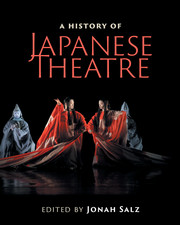Book contents
- Frontmatter
- Contents
- List of figures
- List of tables
- Contributors
- Contributors’ biographies
- Foreword
- Acknowledgments
- Note on Japanese terms
- List of abbreviations
- Timeline
- Editor's introduction
- I Traditional theatres
- Preface to Part I Japanese civilization arises
- II Modern theatres
- Preface to Part II
- III Arcs and patterns
- IV Theatre architecture
- Preface to Part IV Evolution of Japanese theatre architecture
- 16 Premodern patterns of spectatorship and space
- 17 Modernization of theatrical space, 1868–1940
- 18 Postwar theatres: development and diversifi cation
- Interlude National theatres and funding
- V Theatre criticism
- VI Intercultural influences
- Epilogue: Frozen words and mythology
- Further reading
- Index
- References
17 - Modernization of theatrical space, 1868–1940
from Preface to Part IV Evolution of Japanese theatre architecture
Published online by Cambridge University Press: 05 July 2016
- Frontmatter
- Contents
- List of figures
- List of tables
- Contributors
- Contributors’ biographies
- Foreword
- Acknowledgments
- Note on Japanese terms
- List of abbreviations
- Timeline
- Editor's introduction
- I Traditional theatres
- Preface to Part I Japanese civilization arises
- II Modern theatres
- Preface to Part II
- III Arcs and patterns
- IV Theatre architecture
- Preface to Part IV Evolution of Japanese theatre architecture
- 16 Premodern patterns of spectatorship and space
- 17 Modernization of theatrical space, 1868–1940
- 18 Postwar theatres: development and diversifi cation
- Interlude National theatres and funding
- V Theatre criticism
- VI Intercultural influences
- Epilogue: Frozen words and mythology
- Further reading
- Index
- References
Summary
At the beginning of the twentieth century, a number of privately operated theatres appeared that modernized the kabuki theatre through the introduction of new forms and technologies. This section discusses the changing face of Japanese theatre design during the first three decades of the twentieth century through theatres such as the Yūraku-za (Yūraku Theatre, 1908), Teikoku-za (Imperial Theatre, 1911), Teikoku Gekijō (Imperial Theatre, 1911), Tsukiji Shōgekijō (Tsukiji Little Theatre, 1924), and Takarazuka Daigekijō (Takarazuka Grand Theatre, 1924) and its sister, the Tōkyō Takarazuka Gekijō (Tokyo Takarazuka Theatre, 1934). These significant innovations altered the relationship of audience to stage, thereby establishing Japan's modern theatre age.
Kabuki theatre architecture reformed
In keeping with various reforms to kabuki acting and theatre management proposed by the Theatre Reform Association established in 1886, Suematsu Kenchō (1885–1920) expounded the value of Western architectural methods in the design of new Japanese theatres. He believed that innovation began with the initial design, and argued for three-storey brick structures with Western chairs rather than straw-matted floors for seating. He also wanted to abolish the system of selling tickets at adjacent teahouses, to permit audiences to wear shoes, to modernize toilet facilities, and to do away with the hanamichi walkway, while retaining the revolving stage (mawari butai). Suematsu's new theatre reached the planning stage, with English architect Joseph Conder (1852–1920) commissioned as designer, but the plan was finally dropped; such a theatre would not be fully realized until the Imperial Theatre (1911).
Until the Meiji era (1868–1912), kabuki theatres seamlessly merged audience and stage through such elements as the hanamichi, rakandai (onstage seating), the yuka platform situated downstage left for chanters, and partitioned tatami-mat seating spaces (masu) throughout the house. Unlike much Western practice since the Renaissance, sets (except in rare cases) were not constructed on the principle of perspective with a privileged ideal spectator. However, as theatres began to modernize along with the play content, a proscenium arch was added (the earliest version at the new Shintomi-za in 1878) and the walkway and onstage seating were removed, thereby creating a clear separation between stage and audience. Audiences were now forced to view the stage from a single perspective, even in multi-storey auditoria, rather than the multiple axes possible in Edo theatres. The hierarchy of distinctions of privilege and proximity gave way to homogeneous stage and spectator spaces.
- Type
- Chapter
- Information
- A History of Japanese Theatre , pp. 423 - 429Publisher: Cambridge University PressPrint publication year: 2016

